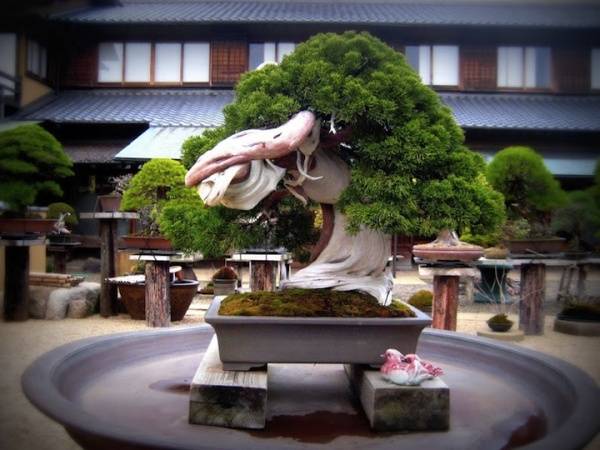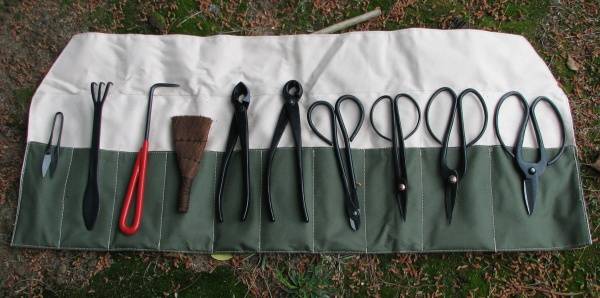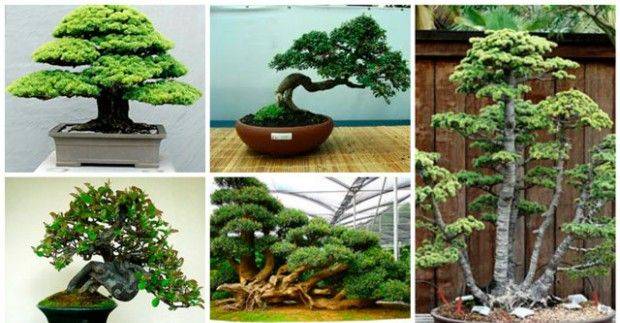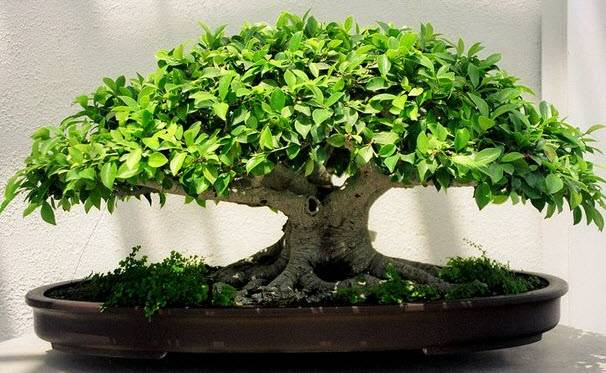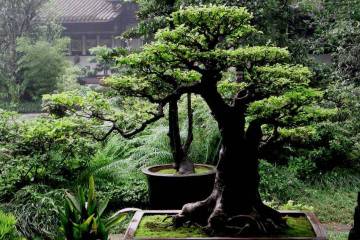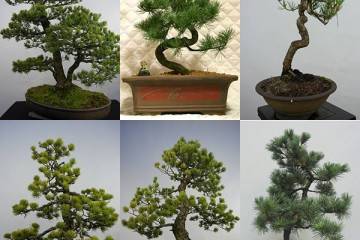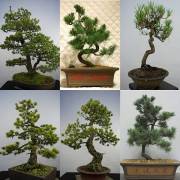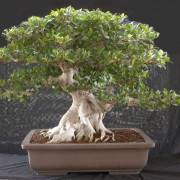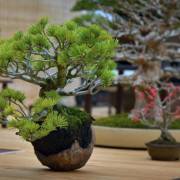What is bonsai in Japan - the art of growing flowers
Content:
Almost everyone knows what bonsai is. A tree in a pot, miniature, with intricately intertwined branches and lush crowns - a bright decoration of a house or garden area.
What is bonsai
In essence, this is a technology for forming the crown of spruce, beech or maple. They are planted in tubs and cared for for many years, bringing the shape to the ideal.
Bonsai - art or craftsmanship
Bonsai is a technique brought to perfection, in which, in addition to physical labor, the soul and thoughts are invested, it is given special importance among the Japanese.
What is bonsai in Japan
Bonsai is not about how to form a small, oddly shaped plant. This is a whole philosophy. Only a person who has a certain mood and state of mind - kindness, delicacy, has a genuine sense of justice and wisdom - can cultivate splendor.
In Europe, this method of decorating vegetation became incredibly popular in the 20th century. Here are just the attitude towards him and the meaning invested differ somewhat from the Japanese view.
It is believed that for creation it is enough to have tolerance and perseverance and to treat your work with love.
The most expensive bonsai in the world
To understand what bonsai is in Japan, and how they treat it there, it is enough to know that in this country all the most unusual and remarkable works of garden art are kept. The movement of individual specimens around the world is carefully monitored.
The most expensive bonsai in the world was formed from pine, which is more than 200 years old. Its price is $ 1.3 million *
The oldest bonsai in the world
The oldest bonsai in the world is from a ficus tree, which is located in Italy, in the Crespi Museum. Its age is over 1000 years.
How does bonsai translate
To understand the essence, you need to know how bonsai is translated. Translated - "tree on a tray", literal definition - a miniature bush on a saucer.
Bonsai for beginners
Bonsai is not an easy art. Experienced gardeners take a lot of time and effort to achieve their goal, not to mention beginners. But with a great desire and the right attitude, growing in rooms or on a plot will become a real hobby that can be brought to perfection.
Bonsai: where to start for a beginner
Before starting to create a bonsai, where to start a beginner, you need to think carefully. There is specialized literature, which tells in detail, bonsai - what it means, master classes are signed.
Bonsai Books
Making a bonsai for beginners will be easier if guided by books:
- P. Lesnievich "Bonsai: the most detailed guide". This is one of the most successful books in which everything is painted in as much detail as possible;
- B. Werner "Bonsai in our home". The author reveals the peculiarities of crown formation, gives recommendations for watering;
- I. and R. Samson "How to create a bonsai." The book is good because it describes how to create bonsai in the garden, at home and in greenhouses.
Basic growing kit
To get a beautiful result, you need to stock up on a special set, which includes all the necessary tools, soil and a pot. Basic tools:
- medium shears for pruning young, thin shoots;
- concave nippers designed to remove thick branches;
- convex nippers are used to form the trunk;
- nippers or scissors with a cutting edge for trimming the root system;
- a root ball knife is used when transplanting;
- a file is necessary for cutting branches;
- wire for forming a crown from young branches;
- tweezers with a curved nose. It removes unnecessary kidneys.
Also included are seeds and fertilizer. You can make the soil yourself:
- conifers - sand (2 parts), sod land (3);
- flowering bonsai - sod soil (7), earth with humus (1), sand (3);
- deciduous species - sand (3), sod land (7).
It is best to use the special mold that comes with the kit. It is enriched with all essential minerals and nutrients.
What styles exist
Outdoor bonsai or indoor bonsai can be formed in a different style:
- Hokidachi (fanny) - deciduous base, straight, even trunk;
- Tekkan (vertical formal) - wide base of the trunk and tapering towards the top;
- Moyogi (vertical informal) - the trunk is S-shaped;
- Shakkan (inclined) - the trunk bends to one side;
- Kengai (cascading) - the top of the vertical trunk goes down;
- Khan Kengai (semi-cascading) - the top of the vertical trunk is directed downward to the side;
- Bunzings (bohemian) - a vertical trunk with a slight curvature, absolutely bald;
- Fukinagashi - all branches are directed in the same direction;
- Ikadabuki (fallen) - a horizontal lying trunk from which branches are pulled up;
- Sharimiki (dead) - trunk with partially removed bark.
One of the most famous styles - sekiyoyu - roots entwine the stone.
Bonsai technique
The main thing that is needed is the timely pruning of branches and their tying with wire to create the desired shape.
What plants are suitable for bonsai in Russian climatic conditions
The basis can be:
- juniper;
- common lilac;
- low almonds;
- thuja, spruce;
- maple;
- Birch;
- viburnum;
- barberry;
- Siberian larch.
Selection and preparation of seeds
The seeds can be purchased at the store or harvested by yourself. If the seed was collected in the fall, it can be immediately placed in the nutrient soil.
If the seeds have a hard shell (cherry, hazel, thorn), they need to be frozen a little.
The seed is lowered into the ground and covered with a thin layer of soil from above. The box with seeds is covered with foil or glass to create a greenhouse effect and taken to a cool place out of direct sunlight, such as a refrigerator. At the end of winter, seedlings will appear in the first weeks of spring.
Transplantation and formation of the root system
Transplanting into open ground or planting seedlings in separate containers is possible only when they reach a height of 10 cm.
In order for the root system to form correctly and not to grow excessively, it must be cut off by 1/3 part.
Crown formation
You can start forming the crown no earlier than 2 weeks after the transplant. The side branches and the top are pinched, the lower stems are trimmed depending on which style is chosen. To achieve the desired shape, the branches are tied around the trunk with wire.
As the branches grow, you need to periodically prune them.
Garden bonsai, or Nivaki bonsai
Bonsai can grow in more than just a room. It looks very nice in the garden on the site.
Street bonsai
A garden bonsai is formed from already mature branches. Recommended base - cypress, larch, elm, yew.
How to trim a tree in the Nivaki style
Step-by-step instructions for forming a Nivaki bonsai:
- In spring, remove skeletal branches, except for those on which there will be a crown. You need to trim so that there are no hemp.
- On the remaining branches, the leading shoots and whorls are removed so that the growth energy is distributed evenly between the remaining branches.
- After pruning, guide the growth of the branches with the help of stretch marks. As they thicken, the stretch marks must be rearranged so that they do not leave marks in the bark.
- After a year, all whorls are removed, only the last is left. In the future, the procedure is carried out regularly until a "plate" of the desired size is formed.
Diy thuja bonsai
Algorithm of actions:
- Select planting material. Submerge it in water to separate bad seeds.
- Put the seeds in the bag in the refrigerator for several weeks. Every 3-4 days, transfer the bag from the top shelf gradually down until it is on the lowest.
- Sow seeds in sand or special mixture.
- When shoots appear, after about 3 weeks, take out the seedlings for a couple of hours in a cool place, then bring them back into the heat. Provide regular watering.
- When the seedlings reach 10 cm, they can be replanted.
The formation of the crown is carried out no earlier than a few months later. To make a bonsai from a thuja with your own hands in a room, the roots need to be pruned periodically.
Secrets of ancient Japanese art
To make a bonsai, you need to adhere to a number of recommendations and know the secrets of success:
- not every tree can embody a certain style;
- starting for the first time, it is better to choose simple, unpretentious flowers that are easy to care for. A bonsai flower, which will delight with lush flowering, looks very beautiful and bright;
- even if an unusual creation is purchased, it must be trimmed regularly, otherwise it will lose its shape.
Before deciding on a bonsai establishment, you need to determine exactly whether there will be enough time for it, because caring for it is a painstaking business that requires a lot of effort. But all work will be fully rewarded with a beautiful and unusual brainchild.
* Prices are for December 2019

